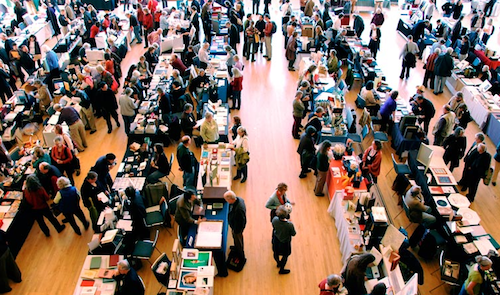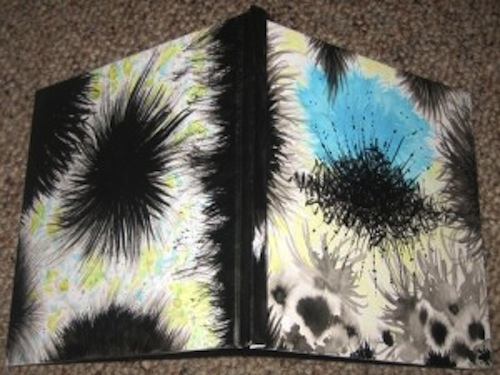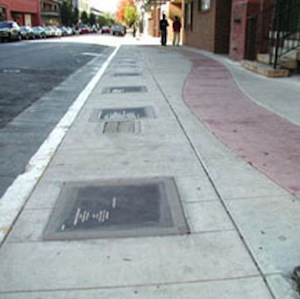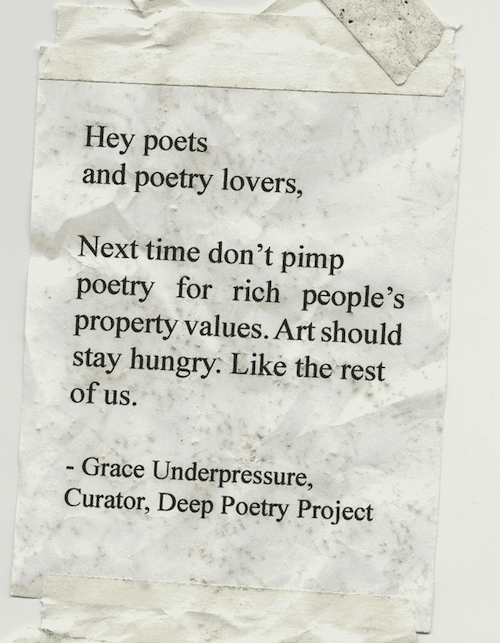
Why should poets care about aura? If the age of mechanical reproduction did not manage to kill off aura—defined, in Walter Benjamin's terms, as the glow of authenticity surrounding any original thing—then the age of digital reproduction surely must. However, what counts as an original in the visual arts doesn't correspond to anything in poetry. A poem doesn't derive its authenticity from any singular, physical presence.
Poetry was never meant to be confined to one privileged place—and when it is, as in a one-of-a-kind artist's book or an inscription on civic monument, the object almost always seems to swallow up the words: in such cases, poetry is defeated by aura.
One of the necessary conditions of aura is scarcity. Maybe aura will be returning to our lives as civilization winds down and things become scarcer. Maybe aura will be returning to books as books become scarcer. A point most relevant to the book arts, which recently held its gathering of the tribes at the CODEX International Book Fair near San Francisco. Book artists are united above all in rejecting mass production—their art, like almost any fine art, is premised on the making of limited-edition, often singular, artifacts. Book artists are thus, more or less self-consciously, committed to the project of producing aura.
Furthermore, in creating their finely worked, intentionally rare, and inherently auratic objects, the book artists who gathered at CODEX this year did not neglect to incorporate the language arts: among the acres of tables strewn with artworks pretending to be books, I noticed the words of, among many others, Etel Adnan, John Ashbery, Bill Berkson, Clark Coolidge, Robert Creeley, Ray DiPalma, Roy Fisher, Kathleen Fraser, Ron Padgett, Michael Palmer, Dennis Phillips, Jerome Rothenberg, and Paul Vangelisti—a veritable choir of postmodern poets all broadcasting aura.
Yet because aura, in Benjamin's sense, applies more to tangible art objects than to linguistic signifiers, the book arts' conjuration of aura is always challenged by the anti-auratic properties of language: namely, its quasi-living urge to disseminate and reproduce itself endlessly.
This tension in the book arts is almost always resolved in favor of the object rather than the word. Because these art books are not intended to circulate widely, the poems that appear in them also seem to be weighed down, encrusted with ornate designs, mere specimens of letter-sequences, embalmed and entombed.
(One book artist, not represented at CODEX, has fought against this tendency toward entombment by multiplying media: Brian Lucas is engaged in creating a series a unique books combining watercolors with poems by a number of his contemporaries. Unlike the lavishly produced artist's books at CODEX, Lucas's books have been put together using inexpensive materials. Moreover, Lucas has inscribed these poems in his own hand, so that the pages possess a warmly epistolary quality, an attempt at human communication across a space of cosmic clouds. Lucas has also overcome the problem of confining the poems to a privileged place by making the books available as downloadable PDFs on his website.)

A plumply designed artist's book can be a soft prison for poetry, but a harder cell is the institutional plaque. When poetry—fulfilling one of its most conventional functions in everyday culture, namely, that of commemorative speech—is mounted on plaques in public spaces, the effect is even more deadening than in artist's books. Here the resemblance to a tomb inscription is too obvious to overlook; any words, but especially poetic words, sculpted into rock will emit a doleful and pathetic aura, overriding any other meaning they may have.
One thinks, in this respect, of the Kerouac monument in downtown Lowell, Massachusetts—but an even bigger example is the "Poetry Walk" in Berkeley, California. Conceived by former U.S. poet laureate Robert Hass, the Poetry Walk consists of 123 cast-iron panels embedded in the sidewalks of Addison Street in downtown Berkeley; each panel is inscribed with a poem. While Hass included one or two examples of Native American traditional poetry, most of the panels represent work by modernist and postmodernist poets active in the Bay Area over the past century. Though the project may be regarded as a laudable attempt to push poetry into the public eye, there's a rather funerary feel to the sequence of panels: one almost expects to find that the poets' remains are interred beneath their words. This abject quality is increased at times by the nasty residues that inevitably accrue on a busy urban sidewalk. The attempt to fix poetry within an auratic frame delivers it instead to a harsh fate, emblematic of its reception in the larger culture: to be mostly hurried by and ignored, but also randomly spat upon and shat upon.

The Poetry Walk also met with some controversy, as local activists objected to the use of poetry to enhance the "property values" of the city's self-styled Arts and Entertainment District. Whatever the validity of this charge, it seems that issues of wealth and privilege are never far removed from instantiations of aura. Poetry has often been treated as a luxury commodity—but such treatments tend to backfire, thanks to the nature of poetry itself. For poetry is a form of language in which meaning, and even meaningless, has nomadic valence—something that can't be possessed or definitively located, and whose existence (to steal a phrase from André Breton) is always elsewhere.

Born in San Antonio, poet Andrew Joron was raised in Germany, Massachusetts, and Montana. He earned ...
Read Full Biography

